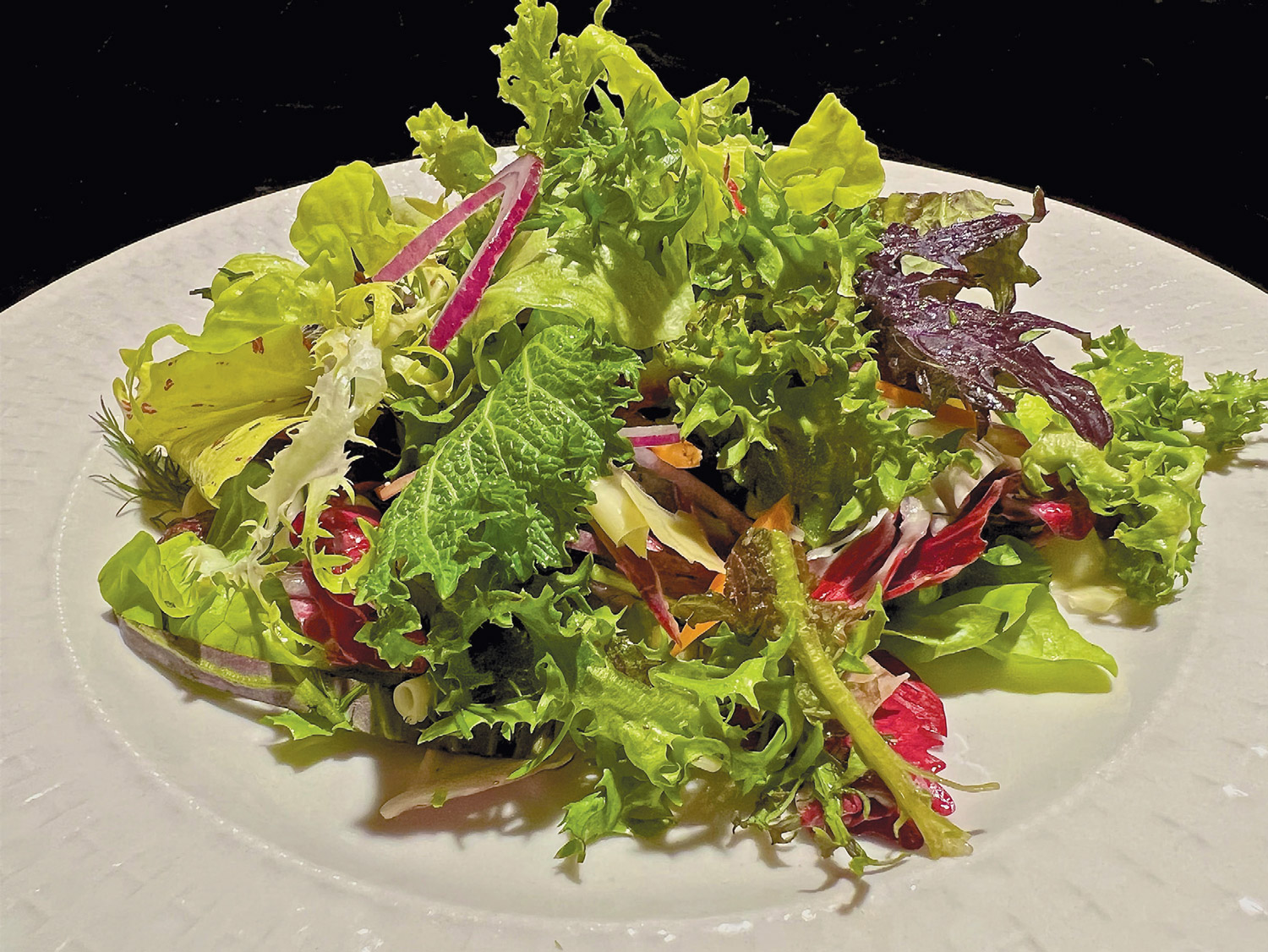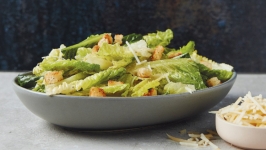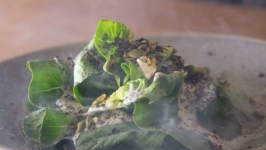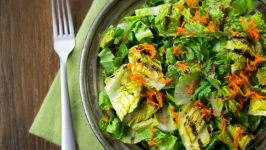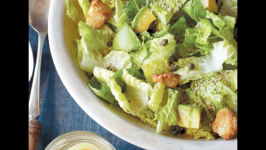How to Dress a Spring Salad
“TO PROPERLY dress a salad,” an old Italian proverb goes, “you need a miser to add the vinegar, a judge to add the salt and a philanthropist to add the oil.” In other words, only three ingredients are needed for dressing a salad, and the proper proportions are: very little vinegar, the “right” amount of salt (not too much, not too little) and a generous amount of oil.
In fact, I would argue that only one ingredient is a necessity: salt. Sal is the ancient Latin word for salt, so salad means salted. I have served tossed green salad with only a pinch of fine salt and people asked me for the recipe!
The other two primary ingredients are a good vinegar (or a comparable acid, like lemon juice) and a good oil (olive, walnut, avocado, sesame or other). The final requirement is that the dressing is freshly made. You will not find “Italian Dressing” in Italy or “French Dressing” in France, or any other bottled dressings in their kitchens.
SALAD IS ALL ABOUT THE GREENS
Salad dressing is a verb, not a noun; it’s a process, not a thing. The role of salad dressing is to enhance the lively flavors of greens, not to drown them.
From time immemorial the world over, even in the desert, spring meant emergent edible greens. Indigenous people foraged the tender spring greens and succeeding generations selected and cultivated varieties for the best taste, ultimately bringing us the greens we enjoy today.
Alice Waters—famed local-food pioneer, restaurateur and chef—returned from a stay in France in the 1960s flat-out in love with French green salads. At the time most Americans were in the grip of iceberg lettuce myopia. The sturdy, but nutritionally and flavor impoverished, iceberg lettuce was developed to withstand packing on ice and shipping by rail from Salinas, California, to New York City in the 1940s (a great “advance” over growing local). It became the dominant— and generally the one and only—salad green available in supermarkets across the country.
Waters went on to change salad history in the U.S. She brought seeds from France, planted them in her backyard and served the garden-picked salads at her restaurant, Chez Panisse in Berkeley. She then convinced a few Marin County farmers to start growing mesclun, a traditional mix of baby spring lettuces and herbs. An abundant variety of salad greens (aka spring mix or salad mix) are now available from local farmers, farmers markets and in grocery stores. Thanks, Alice.
To make a great salad you can select from a variety of baby greens, each with a distinctive taste and mouthfeel. Get to know some leaves. Taste them. You’ll find crunchy, sweet, spicy, tangy, sour, bitter, mineral-y, mustardy, peppery, salty, succulent, pungent, floral, bittersweet, earthy, savory and juicy flavors and textures. You can also try out fresh herbs—like dill, mint, parsley, rosemary, basil or green onions—for your salad. They’re strong so use sparingly.
Greens are over 90% water. Farmers wash and soak them before packing. If they lose their crispness, you can refresh and rehydrate them in an ice water bath for 30 minutes. Then dry them thoroughly; salad dressing will not stick to wet leaves. Many people like to use a salad spinner gizmo (my farmer friends actually use the spin cycle of a repurposed washing machine!). But I am gadget adverse, so I wrap my greens in a terry kitchen towel and blot out the moisture, gently. If I want to hold the greens for later, I'll roll them up in the damp towel and pop them back in the refrigerator for a day or two.
When it comes time to make the salad, stack the leaves up and cut them with a sharp knife into bite-size pieces. Treat them gently; bruising ruptures cell walls, causing dark spots and off flavors. Finely mince or cut the herbs. Any other salad additions should be cut as thin as paper, as delicate as matchsticks, as intimate as a whisper. Less is more. They will be added right before serving. Prepare and set everything aside in the refrigerator.
MASTER DRESSING
Now that your leaves are prepared it’s time to make the Mother of All Dressings: a basic French vinaigrette. Allow 2 ounces of greens for each dinner salad serving. This recipe makes dressing for 4 people or for 8 ounces of greens. Weigh them out if you can. If not ... put “kitchen scale” on your shopping list.
Use good vinegar and good oil. How do you know if the vinegar or oil is “good”? Taste it alone before you make the dressing. Then you will know what you like and don’t like.
Use a glass jar with a screw lid that will hold at least a cup. Into the jar place a pinch of salt, 2 tablespoons good vinegar (or 1 tablespoon lemon juice) and 1 teaspoon Dijon mustard (a natural emulsifier). Tighten the lid and shake vigorously.
Now add 6 tablespoons of good oil. This is the place to add crushed, minced garlic or finely chopped shallot, to your taste. Tighten the lid again and shake the jar for a slow count to 15. The dressing should be emulsified, thoroughly blended and slightly thickened. Now season to taste, which means ... taste it, then add salt or vinegar or oil, shake it up and taste again. (Either tasting directly or by dipping a salad leaf into the dressing and then tasting that.) You are taste-training your brain.
For years my salad dressings tasted too acid, too oily or too flat. Bah! I almost gave up. Then I discovered that salt is the true balancer. Add it a pinch at a time and taste repeatedly.
Other salad dressings are a takeoff on this basic salt/acid/ oil formula with a world of substitutions. Master the standard recipe and you will understand them all.
THE FINAL STEP, PUTTING THEM TOGETHER
Salads must be dressed in the moment—when the rest of the dinner is prepared, and people are ready to sit down to welcome it. At this time put your prepped salad greens and minced herbs in a mixing bowl. (If you have additions for your salad, then temporarily set them aside.) Add half of your prepared dressing and toss lightly with your fingers ... tenderly. Toss until the leaves are lightly coated and well mixed. Taste and add more dressing if needed, a little at a time. (Refrigerate any leftover dressing.) Using your fingers, lightly scoop the salad onto plates or a serving platter. Now place your additions, be they carrot matchsticks, cheese shavings, toasted almond slices or whatever else, around the salad. Wipe your hands and grind on a generous portion of freshly cracked black pepper.
Voilà! Salad perfection.


